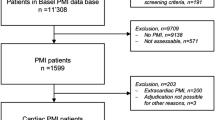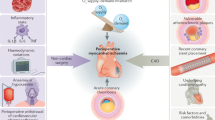Abstract
Unrecognized or silent perioperative myocardial ischemia is common in patients who undergo high-risk surgery, including cystectomy, and could predict cardiac morbidity and mortality in postoperative patients. This disorder is not merely a marker of extensive coronary disease but has a close association with perioperative myocardial infarction (PMI). In a review of published data, including meta-analyses, in the context of high-risk urological surgery, up to 50% of PMIs were found to go unrecognized if only clinical signs and symptoms are considered. Prevention and treatment of these previously unrecognized cardiac events might significantly reduce long-term morbidity and mortality. The emergence of reliable markers of PMI, such as increased levels of troponin I, could help in the detection of events that would have otherwise remained unnoticed. In this Review we examine the effect of these developments in the context of high-risk urological surgery. Changes to preoperative assessment, perioperative management, and prophylaxis of PMI are critically assessed. We performed a prospective audit using postoperative troponin I levels to assess the rate of silent perioperative myocardial ischemia and infarction. An increasingly proactive attitude towards perioperative monitoring for myocardial ischemia and infarction has evolved, and postoperative serial screening with troponin I might be beneficial in high-risk patients undergoing major urological surgery.
Key Points
-
Perioperative myocardial ischemia is common in patients who undergo high-risk surgery, including cystectomy, and has a close association with postoperative myocardial infarction
-
Serial postoperative monitoring of troponin I currently has the highest diagnostic yield for postoperative myocardial infarction
-
In our study of patients who underwent cystectomy, 20% had elevated postoperative troponin I levels within 24 h of surgery
-
Currently, the management of perioperative myocardial infarction is modeled after the established and well-studied treatment of nonoperative myocardial infarction, although the two conditions might have different etiologies
-
An increasingly proactive attitude towards perioperative serial screening with troponin I has evolved, including for high-risk patients with urological conditions
This is a preview of subscription content, access via your institution
Access options
Subscribe to this journal
Receive 12 print issues and online access
$209.00 per year
only $17.42 per issue
Buy this article
- Purchase on Springer Link
- Instant access to full article PDF
Prices may be subject to local taxes which are calculated during checkout
Similar content being viewed by others
References
Office of National Statistics UK (online 21 November 2006). Life exepectancy: life expectancy at 65 reaches record level. [http://www.statistics.gov.uk/CCI/nugget.asp?ID=168&Pos=1&ColRank=2&Rank=448] (accessed 15 April 2007)
Cancer Research UK. Bladder cancer: UK bladder cancer incidence statistics (2007). [http://info.cancerresearchuk.org/cancerstats/types/bladder/incidence/?a=5441#age] (accessed 15 April 2007)
Devereaux PJ et al. (2005) Perioperative cardiac events in patients undergoing noncardiac surgery: a review of the magnitude of the problem, the pathophysiology of the events and methods to estimate and communicate risk. CMAJ 173: 627–634
Lee TH et al. (1999) Derivation and prospective validation of a simple index for prediction of cardiac risk of major noncardiac surgery. Circulation 100: 1043–1049
Fleischmann KE et al. (2003) Association between cardiac and noncardiac complications in patients undergoing noncardiac surgery: outcomes and effects on length of stay. Am J Med 115: 515–520
Kumar R et al. (2001) Adverse cardiac events after surgery: assessing risk in a veteran population. J Gen Intern Med 16: 507–518
Mangano DT et al. (1992) Long-term cardiac prognosis following noncardiac surgery. The Study of Perioperative Ischemia Research Group. JAMA 268: 233–239
Falk E et al. (1995) Coronary plaque disruption. Circulation 92: 657–671
Cohen MC and Aretz TH (1999) Histological analysis of coronary artery lesions in fatal postoperative myocardial infarction. Cardiovasc Pathol 8: 133–139
Dawood MM et al. (1996) Pathology of fatal perioperative myocardial infarction: implications regarding pathophysiology and prevention. Int J Cardiol 57: 37–44
Landesberg G (2003) The pathophysiology of perioperative myocardial infarction: facts and perspectives. J Cardiothorac Vasc Anesth 17: 90–100
Adams JE III et al. (1994) Diagnosis of perioperative myocardial infarction with measurement of cardiac troponin I. N Engl J Med 330: 670–674
Landesberg G et al. (2001) Myocardial infarction after vascular surgery: the role of prolonged stress-induced, ST depression-type ischemia. J Am Coll Cardiol 37: 1839–1845
McFalls EO et al. (2004) Coronary-artery revascularization before elective major vascular surgery. N Engl J Med 351: 2795–2804
Badner NH et al. (1998) Myocardial infarction after noncardiac surgery. Anesthesiology 88: 572–578
Mangano DT et al. (1990) Association of perioperative myocardial ischemia with cardiac morbidity and mortality in men undergoing noncardiac surgery. The Study of Perioperative Ischemia Research Group. N Engl J Med 323: 1781–1788
Fleisher LA et al. (1995) Postoperative myocardial ischemia: etiology of cardiac morbidity or manifestation of underlying disease? J Clin Anesth 7: 97–102
Devereaux PJ et al. (2005) Surveillance and prevention of major perioperative ischemic cardiac events in patients undergoing noncardiac surgery: a review. CMAJ 173: 779–788
Yano K and MacLean CJ (1989) The incidence and prognosis of unrecognized myocardial infarction in the Honolulu, Hawaii, Heart Program. Arch Intern Med 149: 1528–1532
Sheifer SE et al. (2001) Unrecognized myocardial infarction. Ann Intern Med 135: 801–811
Sigurdsson E et al. (1995) Unrecognized myocardial infarction: epidemiology, clinical characteristics, and the prognostic role of angina pectoris. The Reykjavik Study. Ann Intern Med 122: 96–102
Stroumbakis N et al. (1997) Radical cystectomy in the octogenarian. J Urol 158: 2113–2117
Uekado Y et al. (2005) Radical cystectomy for invasive bladder carcinoma in patients 75 years old or older [Japanese]. Hinyokika Kiyo 51: 547–551
Lance RS et al. (2001) Radical cystectomy for invasive bladder cancer in the octogenarian. Oncol Rep 8: 723–726
Parekh DJ et al. (2002) Orthotopic neobladder following radical cystectomy in patients with high perioperative risk and co-morbid medical conditions. J Urol 168: 2454–2456
Farnham SB et al. (2004) Benefit of radical cystectomy in the elderly patient with significant co-morbidities. Urol Oncol 22: 178–181
Bloom HJ et al. (1982) Treatment of T3 bladder cancer: controlled trial of pre-operative radiotherapy and radical cystectomy versus radical radiotherapy. Br J Urol 54: 136–151
Figueroa AJ et al. (1998) Radical cystectomy for elderly patients with bladder carcinoma: an updated experience with 404 patients. Cancer 83: 141–147
Quek ML et al. (2006) A critical analysis of perioperative mortality from radical cystectomy. J Urol 175: 886–889
Miller DC et al. (2003) The impact of co-morbid disease on cancer control and survival following radical cystectomy. J Urol 169: 105–109
Manikandan R et al. (2005) Troponin T and N-terminal pro-brain natriuretic peptide changes in patients undergoing transurethral resection of the prostate. J Urol 174: 1892–1895
Taher T et al. (2002) Assessment and reporting of perioperative cardiac risk by Canadian general internists: art or science? J Gen Intern Med 17: 933–936
Kertai MD et al. (2003) A meta-analysis comparing the prognostic accuracy of six diagnostic tests for predicting perioperative cardiac risk in patients undergoing major vascular surgery. Heart 89: 1327–1334
Etchells E et al. (2002) Semiquantitative dipyridamole myocardial stress perfusion imaging for cardiac risk assessment before noncardiac vascular surgery: a meta-analysis. J Vasc Surg 36: 534–540
Alpert JS et al. (2000) Myocardial infarction redefined—a consensus document of The Joint European Society of Cardiology/American College of Cardiology Committee for the redefinition of myocardial infarction. J Am Coll Cardiol 36: 959–969
Filipovic M et al. (2003) Heart rate variability and cardiac troponin I are incremental and independent predictors of one-year all-cause mortality after major noncardiac surgery in patients at risk of coronary artery disease. J Am Coll Cardiol 42: 1767–1776
Babuin L and Jaffe AS (2005) Troponin: the biomarker of choice for the detection of cardiac injury. CMAJ 173: 1191–1202
Kim LJ et al. (2002) Cardiac troponin I predicts short-term mortality in vascular surgery patients. Circulation 106: 2366–2371
Kertai MD et al. (2004) Long-term prognostic value of asymptomatic cardiac troponin T elevations in patients after major vascular surgery. Eur J Vasc Endovasc Surg 28: 59–66
Rinfret S et al. (2004) Value of immediate postoperative electrocardiogram to update risk stratification after major noncardiac surgery. Am J Cardiol 94: 1017–1022
Martinez EA et al. (2005) Intermittent cardiac troponin-I screening is an effective means of surveillance for a perioperative myocardial infarction. J Cardiothorac Vasc Anesth 19: 577–582
Howell SJ et al. (2006) Relationship between perioperative troponin elevation and other indicators of myocardial injury in vascular surgery patients. Br J Anaesth 96: 303–309
Bursi F et al. (2005) Vascular surgery patients: perioperative and long-term risk according to the ACC/AHA guidelines, the additive role of post-operative troponin elevation. Eur Heart J 26: 2448–2456
Mangano DT et al. (1996) Effect of atenolol on mortality and cardiovascular morbidity after noncardiac surgery. Multicenter Study of Perioperative Ischemia Research Group. N Engl J Med 335: 1713–1720
Wijeysundera DN et al. (2003) Alpha-2 adrenergic agonists to prevent perioperative cardiovascular complications: a meta-analysis. Am J Med 114: 742–752
Schouten O et al. (2006) A meta-analysis of safety and effectiveness of perioperative beta-blocker use for the prevention of cardiac events in different types of noncardiac surgery. Coron Artery Dis 17: 173–179
Back MR et al. (2004) Long-term survival after vascular surgery: specific influence of cardiac factors and implications for preoperative evaluation. J Vasc Surg 40: 752–760
Author information
Authors and Affiliations
Corresponding author
Ethics declarations
Competing interests
The authors declare no competing financial interests.
Rights and permissions
About this article
Cite this article
Winkler, M., Mayer, E., Hrouda, D. et al. Therapy insight: prophylaxis, monitoring and treatment of perioperative myocardial ischemia with emphasis on urological surgery. Nat Rev Urol 4, 333–340 (2007). https://doi.org/10.1038/ncpuro0817
Received:
Accepted:
Issue Date:
DOI: https://doi.org/10.1038/ncpuro0817



